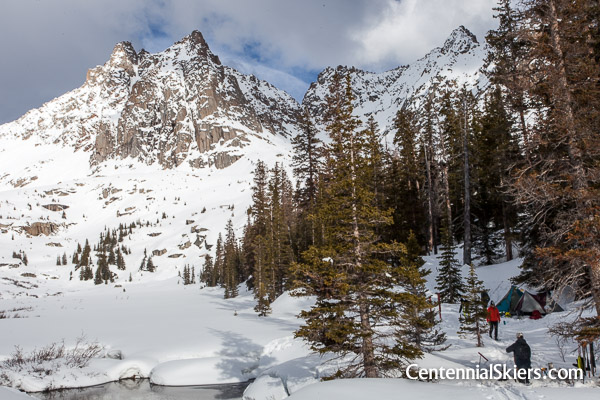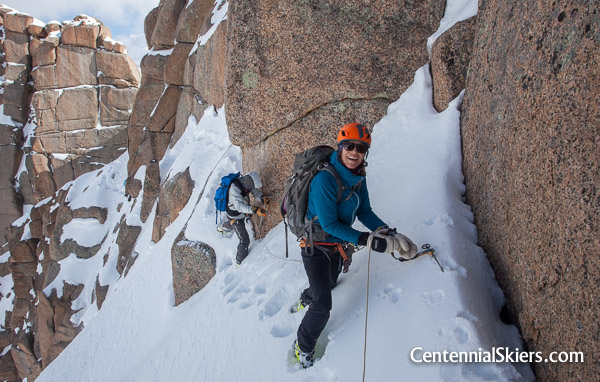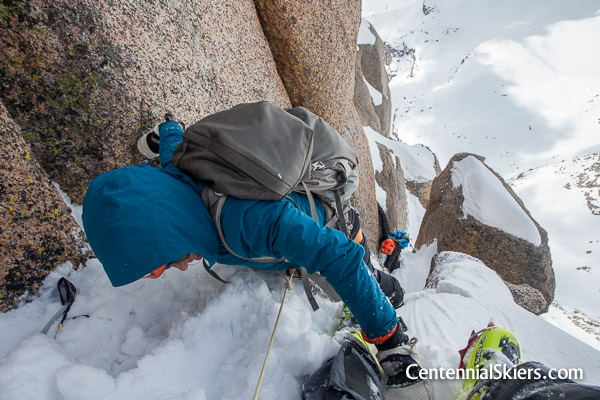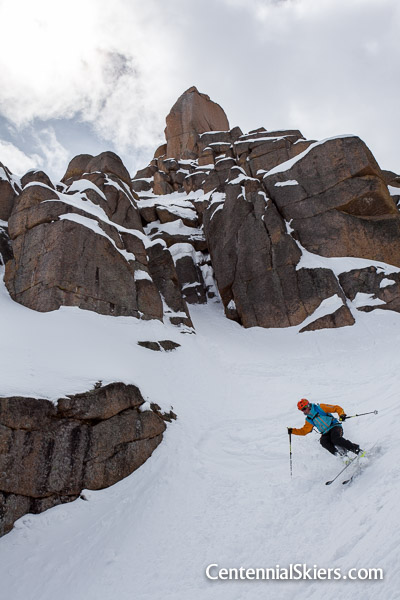#41 Jagged Mountain 13,824 ft.
Date: May 27, 2015
Team: Christy, Dav, Ted, Pete Gaston
Route: North Face “Jagged” Couloir

We climbed and skied Jagged Mountain, our 100th and final ski descent of the Centennial Ski Project. Christy, Chris, and I, along with our friend Pete Gaston, emerged from a four day trip in the Weminuche Wilderness on Thursday, in awe of a mountain that presented more challenges than any other we’ve encountered through this project to date. It was a fitting final summit, a microcosm to the whole incredible larger objective.
Our goal to climb and ski the 100 tallest mountains in Colorado was almost monumental in scale, and our experience through it all can not be summed up in a single blog post. It would be a disservice to it to even try. The three of us invested so much time, effort, energy, and focus, it will likely be a while before we’ve processed it all. That said, we are incredibly grateful for the whole experience— the time out in the mountains doing what we love, with the partners and friends who joined us along the way. We feel fortunate to live in a place like Colorado, where something like this is even possible.

About Jagged Mountain
Jagged Mountain, 13,824 feet, is considered to be the most remote, rugged, and challenging summit of the Centennials. A nine mile approach on a steep, unmaintained trail along Noname Creek is required, and it takes more than a day to complete. Add isothermic snow, mud, and a seemingly impossible number of downed trees to navigate with massive backpacks to the challenge of just getting to camp.




Once at high camp you need to get prepared for the most sustained and airy climbing of any high summit in the state, which can be daunting even in dry, summer conditions. Add skis to the mix, and snow on the steep rock faces, and it suddenly feels as though it’s in a category of difficulty unmatched in Colorado. The terrain steepens as you move higher, and several cruxes of 5th class climbing are required to get to the top. And of course if you make it to the 13,824 foot summit, you’re only halfway done. You have a lot of work to do to get back home.

Jagged is one of four Centennials that are not skiable from their exact summits. The others are Wetterhorn Peak, Dallas Peak, and Teakettle Mountain. In these instances the topography simply doesn’t allow for skiable lines to fill in, and the accepted practice is to climb to the summit and then descend and ski from the highest point possible.
We had been unable to find any info on climbing Jagged with snow, much less with skis. Our recon, which included an aerial flight around the mountain last April, showed the most practical ski route to be the Jagged Couloir, a tight, north-facing chute to the lookers left of the summit. Due to the lack of proven ski history here and our recon photos, we had determined this couloir to be the highest skiable snow line on the mountain. Photos of the south side didn’t offer any better (higher) skiing options.
We needed to climb the couloir, stash our skis, complete the route to the summit, rappel/downclimb to our skis, and ski the Jagged Couloir off the mountain. It’s our opinion that this is the most aesthetic style to ski Jagged, according to current standards of ski mountaineering.
Our Attempt
As prepared as we could be, we hopped on the train and headed into the Weminuche again. We got off at Needleton in pouring rain, and made our way to a comfortable campsite at the base of Noname Creek where we stayed for the night. The following morning we were up early to continue the approach to our high camp below Jagged Pass.
Rugged terrain made for a slow pace and we found ourselves in more passing spring weather (rain and graupel), but we made it to our planned camp near treeline by early afternoon. There was a lot of new snow up high from all the recent wet weather, so we dug out a camp and got settled. We were in good position for our attempt on Jagged the following morning, and we had all afternoon to dry things out, hydrate, and prepare.

The alarm clock went off at 4:45am. We weren’t very far from the mountain but we still had to climb up and over Jagged Pass. Since the sun is strong this time of May, we needed the early start to stay ahead of warming temperatures and its effect on the snow.


The four of us skinned up to Jagged Pass,13,010 ft. where the North Face of Jagged Mountain came into view. The weather was good, it was early, and we had a plan— it was time to get this done. We traversed over to the couloir and headed up.



At the top of the couloir we stashed our skis and proceeded up the technical sections, which were covered with more snow than we had expected. Passing clouds kept things cool but it wouldn’t be long before that snow heated up and became sloppy, and prone to wet slabs. We made good time through the cruxes of the north side, all the way up to the notch that led to the big south side traverse. The airy traverse was followed by a steep chimney, which in turn led to the flat summit block. It ended up being fun, airy, alpine climbing conditions.





Before we knew it we were on top of Jagged, our final summit and the most uncertain of them all. We took in the stunning 360 views of the Weminuche Peaks that surrounding Jagged, and felt immensely grateful to be there. We were psyched to have made it to the summit but we weren’t celebrating yet, we still had a lot work ahead of us.



Two rappels and some downclimbing brought us back to our skis. We poked our way down the runneled Jagged Couloir to a point where we could traverse back to Jagged Pass, and back down to camp. We were done. It didn’t matter that a miserable descent down to the Animas River still awaited us, we had just come to realize a goal that at times seemed unattainable at times. We made it down to our low camp by dark and it began sink in. We did it.







Pages
- #1 Grizzly Peak – 13,988 ft.
- #2 Stewart Peak -13,983 ft.
- #3 Columbia Point – 13,980 ft.
- #4 Pigeon Peak – 13,972 ft.
- #5 Mount Ouray – 13,971 ft.
- #6 Ice Mountain – 13,951 ft.
- #7 Fletcher Mountain – 13,951 ft.
- #8 Pacific Peak – 13,950 ft.
- #9 Cathedral Peak – 13,943 ft.
- #10 French Mountain – 13,940 ft.
- #11 Mount Hope – 13,933 ft.
- #12 Thunder Pyramid – 13,932 ft.
- #13 Mount Adams – 13,931 ft.
- #14 Gladstone Peak – 13,913 ft.
- #15 Mount Meeker – 13,911 ft.
- #16 Casco Peak – 13,908 ft.
- #17 Red Mountain – 13,908 ft.
- #18 Emerald Mountain – 13,904 ft.
- #19 Horseshoe Mtn. – 13,898 ft.
- #20 “Phoenix Peak” – 13,895 ft.
- #21 Vermillion Peak – 13,894 ft.
- #22 Cronin Peak – 13,870 ft.
- #23 Mount Buckskin – 13,865 ft.
- #24 Vestal Peak – 13,864 ft.
- #25 Jones Mountain – 13,860 ft.
- #26 North Apostle – 13,860 ft.
- #27 Clinton Peak – 13,857 ft.
- #28 Dyer Mountain – 13,855 ft.
- #29 Crystal Peak – 13,852 ft.
- #30 Mount Edwards – 13,850 ft.
- #31 California Peak – 13,849 ft.
- #32 Mount Oklahoma – 13,845 ft.
- #33 Half Peak – 13,841 ft.
- #34 Atlantic Peak – 13,841 ft.
- #35 Hagerman Peak – 13,841 ft.
- #36 Turret Peak – 13,835 ft.
- #37 PT 13,832
- #38 Holy Cross Ridge – 13,831 ft.
- #39 Jupiter Mountain- 13,830 ft.
- #40 “Huerfano Peak” – 13,828 ft.
- #41 Jagged Mountain – 13,824 ft.
- #42 “Lackawanna” – 13,823 ft.
- #43 Mount SiIverheels – 13,822 ft.
- #44 Rio Grande Pyramid – 13,821 ft.
- #45 Teakettle Mountain – 13,819 ft.
- #46 PT 13,811 – 13,811 ft.
- #47 Dallas Peak – 13,809 ft.
